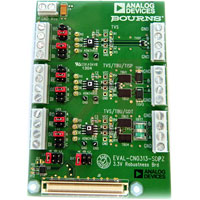EVAL-CN0313-SDPZ产品概述
In real industrial and instrumentation (I&I) applications, RS-485 communication links must work in harsh electromagnetic environments. Large transient voltages caused by lightning strikes, electrostatic discharge, and other electromagnetic phenomenon can cause damage to communication ports. These data ports must meet certain electromagnetic compatibility (EMC) regulations to ensure that they can survive in their final installation environments.
Within these requirements, there are three transient immunity standards: electrostatic discharge, electrical fast transients, and surge. Leaving EMC considerations to the end of the design cycle leads to penalties, such as engineering budget and schedule overruns. Many EMC problems are not simple or obvious and must be considered at the start of product design.
This application note describes each of these transients, presents the design solution methodology, and demonstrates three different EMC-compliant solutions for three different cost/protection levels for RS-485 communication ports. These different solutions are illustrated in Figure 1.
Analog Devices, Inc., and Bourns, Inc., have partnered to extend their offering of system oriented solutions by co-developing the industry’s first EMC-compliant RS-485 interface customer design tool.
This tool provides, up to and including, Level 4 protection levels for IEC 61000-4-2 ESD, IEC 61000-4-4 EFT, and IEC 61000-4-5 surge. It gives designers the design options depending upon the level of protection required and available budgets. These design tools allow designers to reduce risk of project slippage due to EMC problems by considering them at the start of the design cycle.


 Datasheet
Datasheet